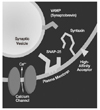Clinical Tips and Recent Advances in Cosmetic Uses of Botulinum Toxin Including Mesobotox
Article information
Abstract
In this article, general clinical tips when handling the botox are reviewed including its reconstitution, storage, comparison of commercial products, safety, immunogenicity when repeatedly injected, etc. In addition, recent advances in the clinical use of botox in the cosmetic field including mesobotox, an intradermal injection of botox are comprehensively discussed. Mesobotox is a hybrid word from mesotherapy and botox, and is a new technique combined with conventional intramuscular injection and intradermal injection of botox. When injected intradermally, botox seems to bring about dermal edema due to transient and mild lymphatic insufficiency from underlying muscular paralysis. Botox can also relax smooth muscle of dermal vasculature. Dermal edema can make the skin look tight in turn. Therefore, fine static wrinkles are improved and dilated pores are also improved with mesobotox in addition to the original effect of botox on expression lines. Another important point of mesobotox is the improvement of aged appearance including elevation of the lateral part of eyebrow and contouring the masseteric hypertrophy. The major advantage of mesobotox is that it gives a natural-look because it does not paralyze the deeper part of facial expression muscles even if we inject botox on the mid to lower part of the face.



